Create a Grimy Text Treatment with a Pen Tablet
Tutorials | April 15th, 2010
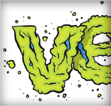
In this tutorial I will show you how to create a grimy text treatment utilizing Illustrator’s Blog brush, Live Paint, and a pen tablet. You can easily apply these techniques to other illustrates, type treatments and logos.
Final Image
Below is the final type treatment we be working towards.
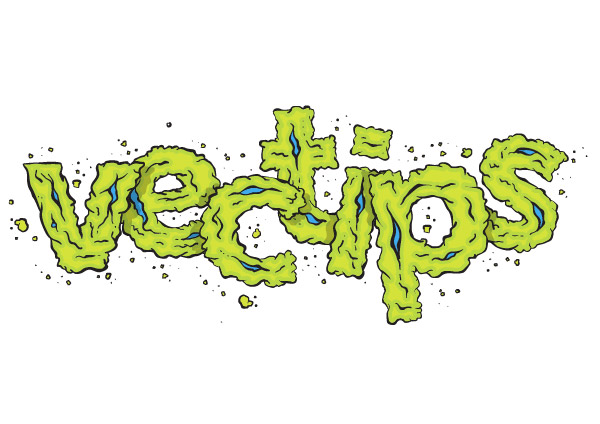
Tutorial Details
- Program : Adobe Illustrator CS4 (This tutorial uses the Blob Brush, a tool specific to CS4. If you have an earlier version of Illustrator, refer to the Alternate Tutorial Methods step at the end of this post.)
- Hardware Needed: Pen Tablet (I used a Wacom Intous4 for the tutorial. If you don’t have a pen tablet, refer to the Alternate Tutorial Methods step at the end of the tutorial for other methods for creating the tutorial.)
- Difficulty: Intermediate
- Topics Covered: Blob Brush, Live Paint
- Estimated Completion Time: 1.5 hour – 2 hours
Step 1
Create a new document and type out some text with the Text tool (T). Change the fill of the text to a light gray.
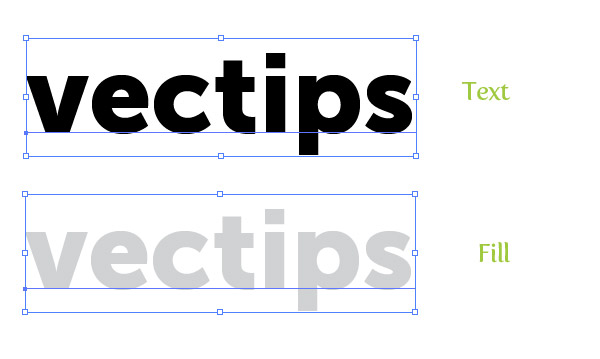
Step 2
In the Layers panel, rename your layer to “Template” by double-clicking on the layer and changing the name in the Layer Options dialog. Next, lock the layer. Create a new layer by pressing the Create New Layer button from the Layers panel and rename this layer to “Artwork”.
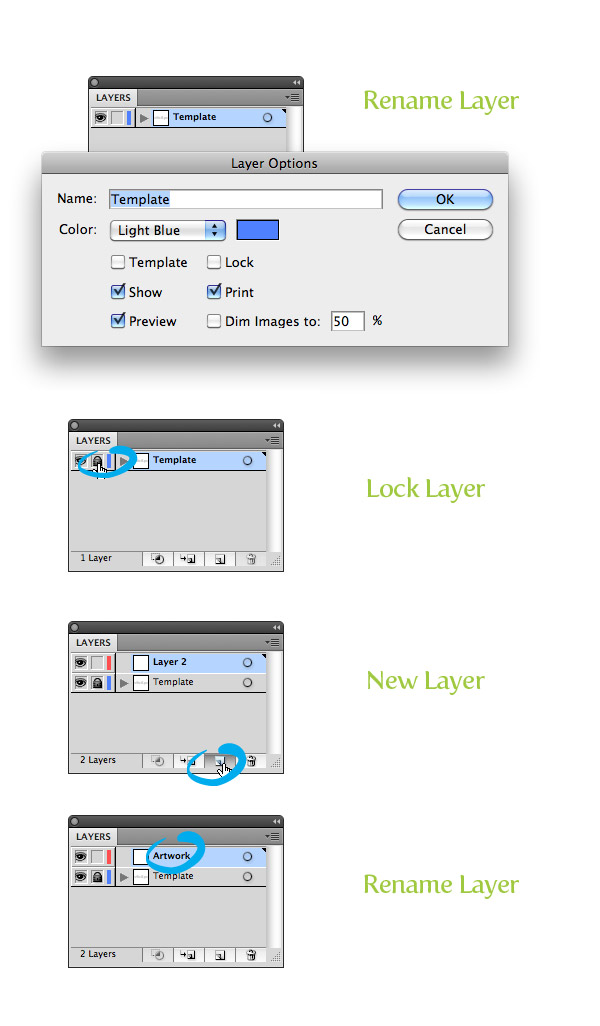
Step 3
For drawing the outlines and contours of the treatment, we are going to use the Blob Brush(Shift + B) and a pen tablet. First, you need to set up the Blob Brush (Shift + B) to use the pressure sensitivity of the tablet. To do this, double-click on the Blob Brush (Shift + B) in the Tools Panel. In the Blob Brush Tool Options, you really only have to change: the Fidelity to 1, Smoothness to 0, Size to 2, select Pressure from the size drop-down menu, and change the Variation to 2. Now with these settings, the Blob Brush will utilize the pen tablet’s pressure sensitivity. Moreover, adjusting the Fidelity and Smoothness creates a brush stroke with a hand-drawn feel.
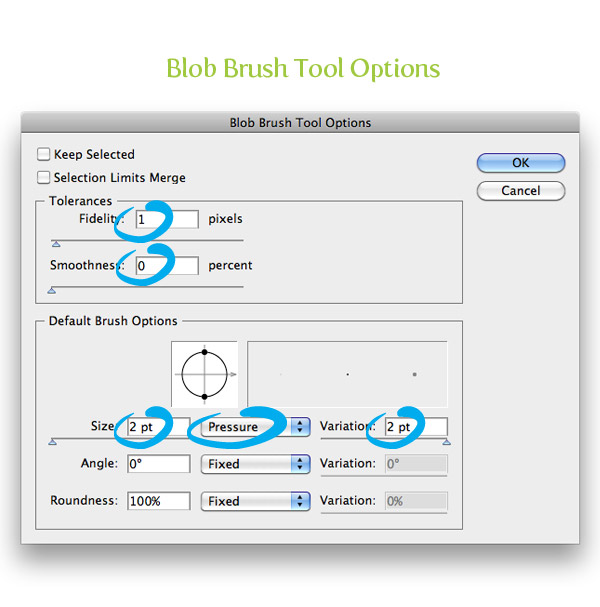
Step 4
Zoom in really close to you first letter and start tracing it with the Blob Brush (Shift + B). When tracing, vary the pressure on your pen tablet to get a hand-drawn type of stroke. Also, use multiple brush strokes in your trace, don’t just trace the whole letter with one brush stroke. I also like to start each brush stroke very light and end very light, creating tapered lines.
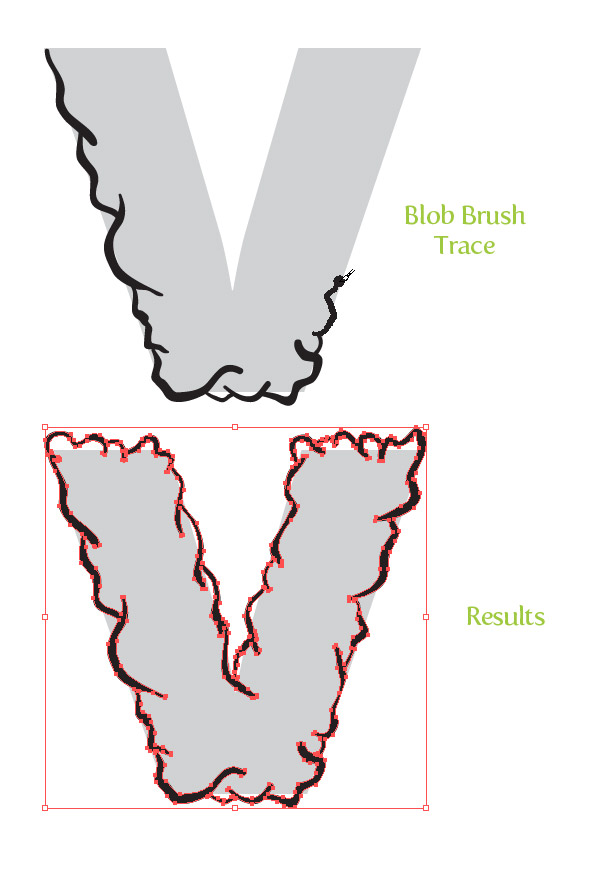
Step 5
Once you are done tracing the first letter, create some more Brush strokes within the letter making it more grimy!
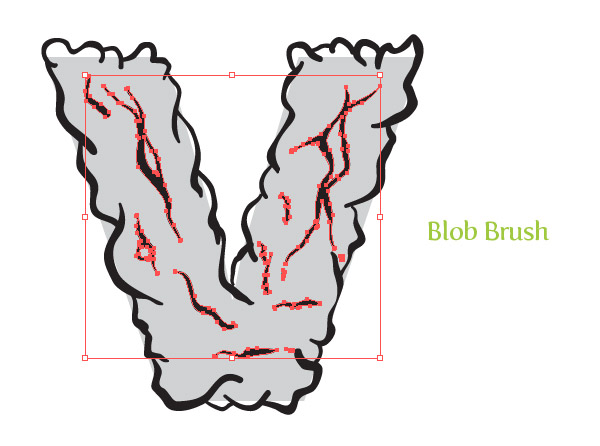
Step 6
Now that we have our brush strokes, we can add some color to the letter. First, select all the letter artwork and select the Live Paint Bucket (K) from the Tools Panel. The Live Paint Bucket (K) converts the artwork to a Live Paint object. Now you can simply hover over the area you want to fill, cycle through your swatches with your arrow keys, and click the areas to fill.
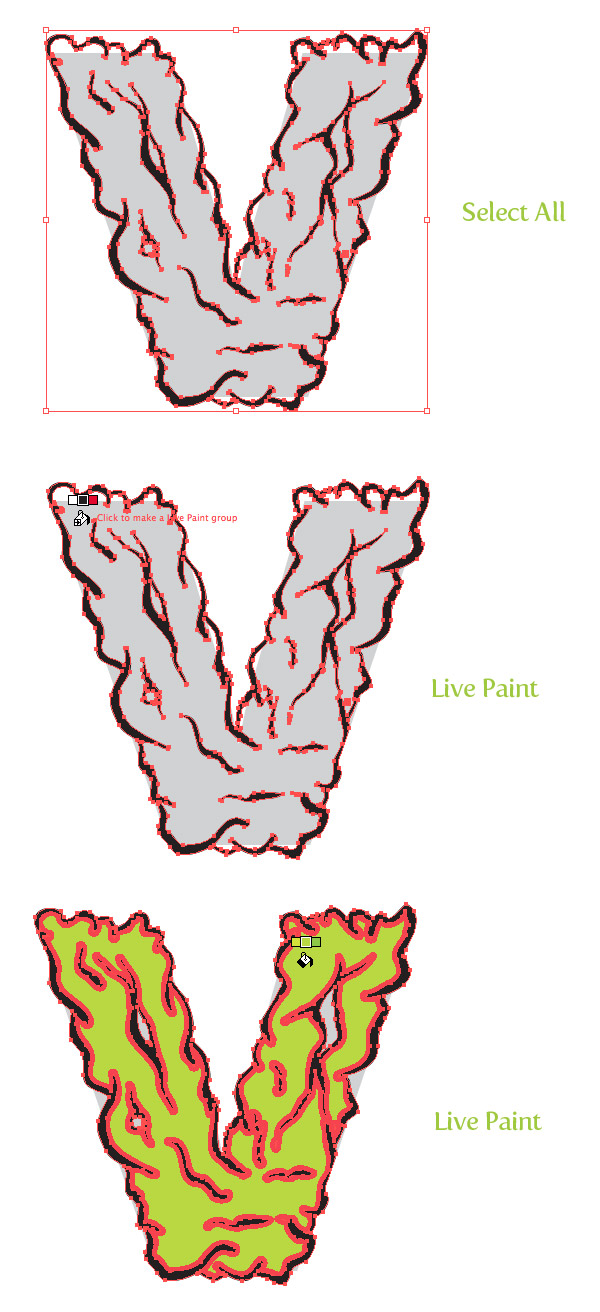
Step 7
Select your Live Paint object and go Object > Live Paint > Expand. Next, ungroup the object (Command + Shift + G) a couple of times.
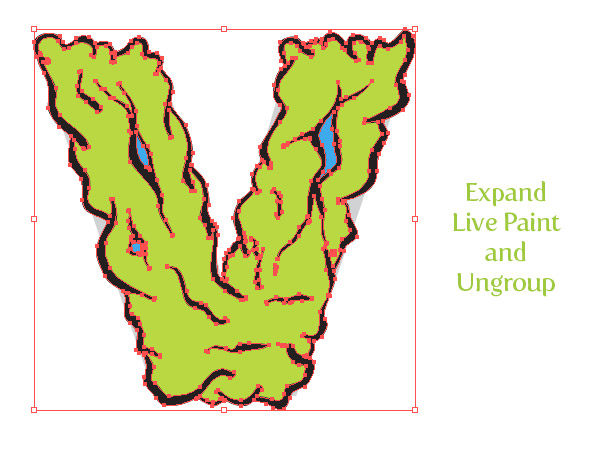
Step 8
Select your main letter color and go Object > Path > Offset. In the Offset Path dialog, change the Offset to -3 px. This value might be larger or smaller depending on the original size of your artwork. Fill the offset with a lighter shade of color from the original.
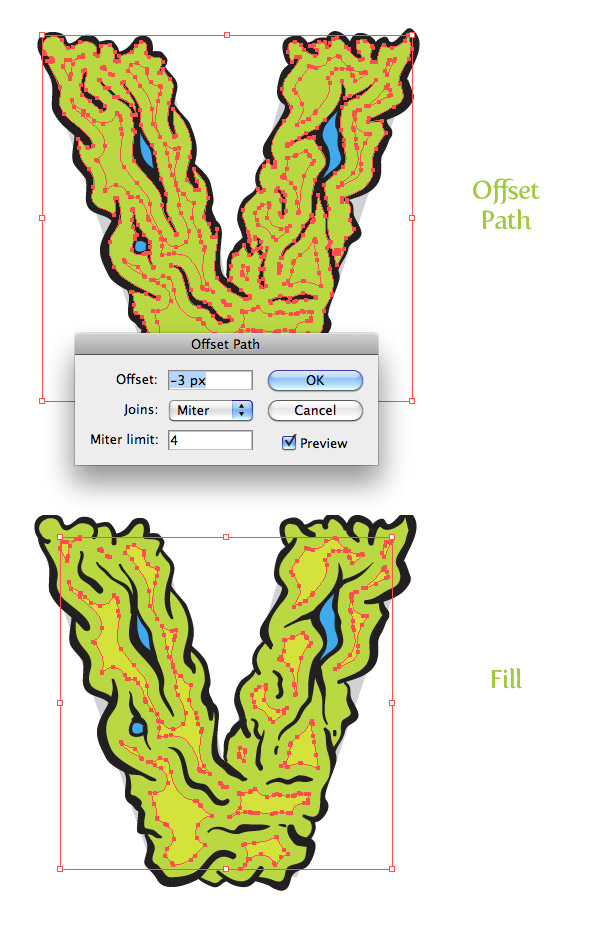
Step 9
We are done with the first letter! Now, repeat Steps 4-8 for each letter. It might take some time, but you will start to get quicker once you have done it a couple of times.
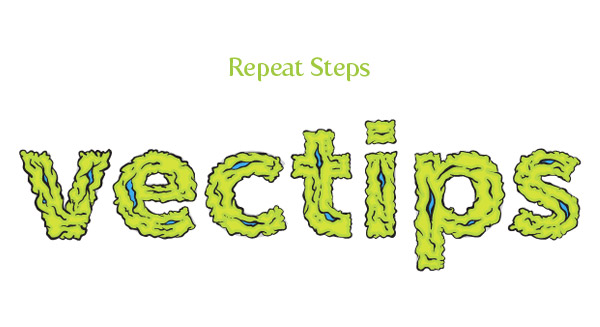
Step 10
Now that we have all the letters, we don’t need the “Template” layer anymore. Simply press the Visibility icon in the Layers panel to hide it. Next, Group (Command + G) each individual letter’s artwork. It makes it easy to modify the letters in the coming steps.
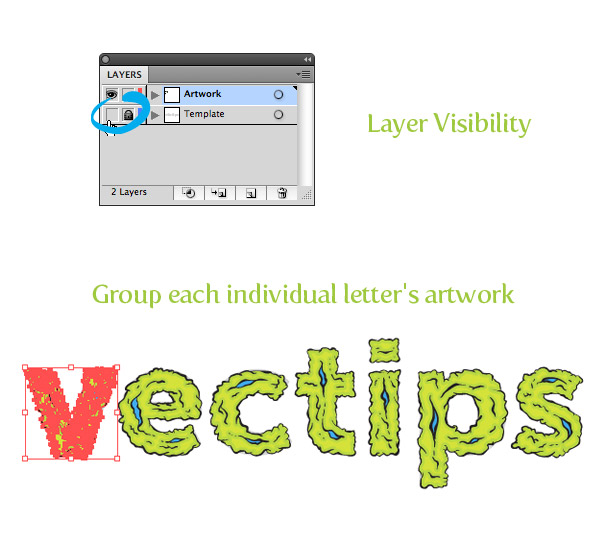
Step 11
Use the Selection tool (V) to move and rotate each letter. Use the Illustrator’s Arrange functions to bring some of the letters to the front and some to the back by Going Object > Arrange.
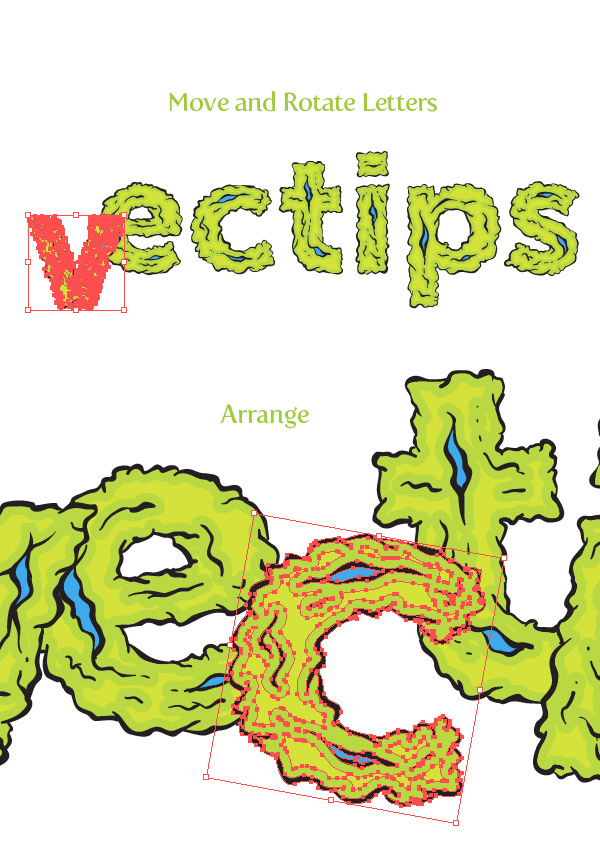
Step 12
To give the treatment a little more depth, we can create some shadows. To start, select the first two letters, Copy (Command + C), and Paste in Front (Command + F). Select the first letter’s copy and press the Unite button from the Pathfinder panel. Select the second letter’s copy and again, press the Untie button from the Pathfinder panel. Select the first letter’s copy and move it down and to the right. Select both copies and press the Intersect button from the Pathfinder panel. Change the fill of the new shape to a light gray, set the Blending Mode to Multiply from the Transparency panel, and Arrange the shape so it is behind the first letter, but in front on the second.

Step 13
Repeat the previous step for each letter’s shadow.
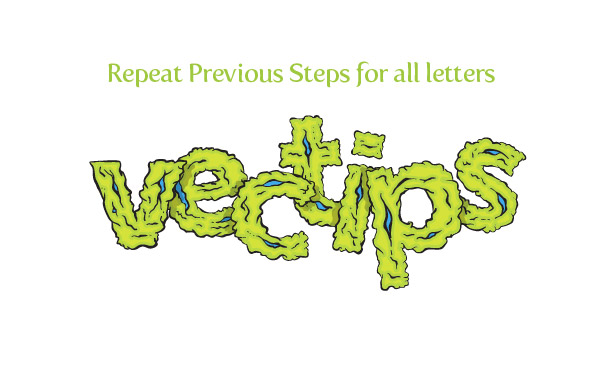
Step 14
To make the treatment a little more grimy, use the Blob Brush and create little specs around the text. Use the same Live Paint techniques as discussed before to fill in the speck shapes. That is it, done!
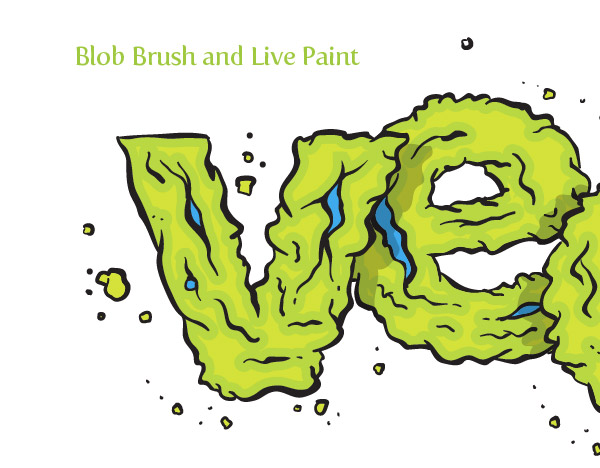
Final Image
Below is the final type treatment again. Try using the Blob brush and pen tablet on other illustrations and type treatments, it’s fun!

Alternate Tutorial Methods
Calligraphic Brush
If you don’t have CS4 but you do have a pen tablet, you can use a Calligraphic brush instead of the Blob Brush (Shift +B) for the outlines of the type treatment. If you have CS3, you can use the Live Paint technique or you can just create shapes of color with the Pen tool (P), Pencil tool (N), or another tool of your choice. To set up a Calligraphic brush with the same settings as the Blob Brush settings in this tutorial, click the New Brush Icon in the Brush panel. When the New Brush dialog opens, choose New Calligraphic Brush. In the Calligraphic Brush Options, change the Angle to 0, the Roundness to 100%, the Diameter to 2 pt, select Pressure from the Size drop-down menu, and change the Variation to 2 pt. Now you can outline the image with the same pressure sensitivity as the Blob Brush.
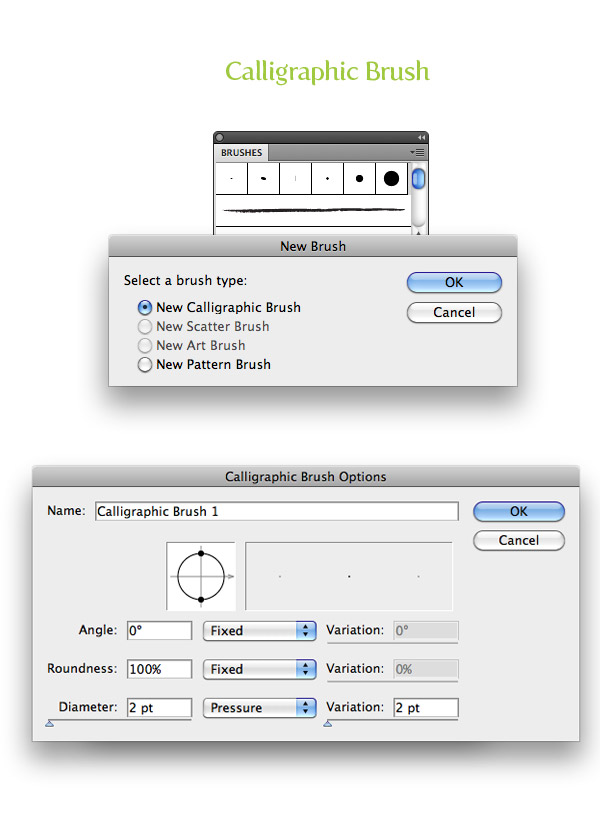
Art Brushes
If you don’t have a pen tablet, you can always use an Art brush for the outlines instead of the Blob Brush (Shift +B) . Art brushes are still very versatile, but they will not use you pen tablets pressure sensitivity. Still, you can find a brush that has similar tapered lines. My previous article Create Sketchy-Style Vectors will help in finding and creating Art brushes.
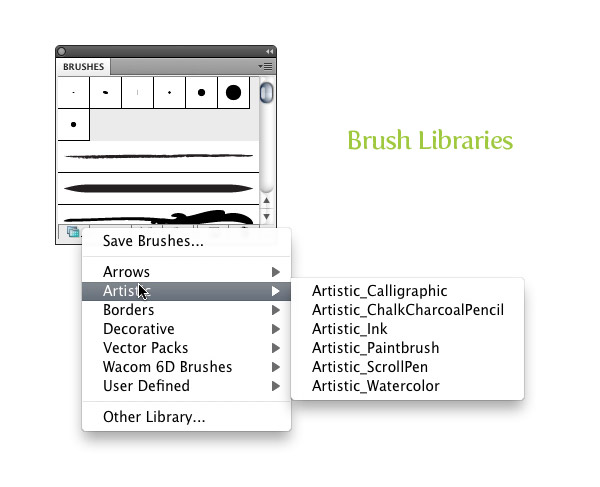









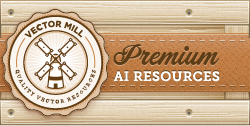










This is great. Thanks for sharing! Though it’s now obvious to me, I didn’t even think to use a pen tablet with illustrator. I’m so focused on using it with ps. thanks for the eye opener.
Great tutorial, thanks for sharing. I will definitely try it later
Very cool tutorial, really nice.
This is awesome! Just got a Intuos4 large as a birthday present which is a major upgrade over my little A6 Graphire so this tut is ideal for a little practice.
Really like the overall effect and it is a good use of the pen pressure so I’ll be sure to give this a go (and get into the habit of using Illustrator for these kind of things more often). Thanks,
oh oh. Great, the final result is very impressive. Thanks, Rype!
Wow! One of the bests tuts!
Cheers Rype great tutorial! I’ll be using this on my future t-shirt and poster designs
Thanks Ryan – another great tutorial. I really have to stop using the Wacom tablet as just a large wireless mouse pad!
Great artwork! Great techniques!
Some great techniques in here! Love the end result. Gonna try later.
This is a great tutorial! I can’t wait until I can get a new Wacom so I can try it out.
Great job…!!!
Great tutorial! What font is the type in?
It is Museo Sans.
Nice tut. But I cant create the shawdows, Pathfinder says the paths dont intersect on the intersect-command. Any hints?
Any hints?
This one left me with a hungry feeling. It looks like sweet beer battered and fried alphabet chips to me.
Great tutorial! I was actually just looking for something similar a week or so ago and could not find a single article or tutorial online. Many thanks for the instruction!
Amazing….the shadowing really adds a lot!
great vector text tutorial.fantastic artwork
web designer
http://www.scrapsforever.com
Loved the way to use pen tablet.
One thing extra thing I did to the letters while I was tracing them was when I was done I would use the eraser and would trim some of my strokes. I personally think it helped it quite a bit. Well anyways… great tutorial!
Really great tutorial, thanks! I’ve got a pen tablet, but CS3 so I used the calligraphy brush and it worked well. I’m really glad you added that tip. With CS4 (and now CS5) I find some articles which i can’t really relate to because they use features I don’t have.
Here’s what I made
http://www.kyleism.com/?p=114
Nice effect . If possible add more stuff like this .Your readers will be helpful .Thnx
Brilliant tutorial – love the look!
Great tutorial!
Helpful tutorial. I’m doing it in my design now.
Thanks a lot for sharing.
Nice tutorial! i find good art work isn’t easy wen using a tablet but this was really easy to follow. loads of really useful tips. thanks
I can’t believe I have been using Ilustrator for 8 years now, and this is the first time I have realised how to use the blob brush! BIG THANKS VECTIPS!
thanks for tutorial
This one is (like always) really tight!!
Cheers Rype great tutorial! I’ll be using this on my future t-shirt and poster designs
This is a great tutorial and just what I was looking for. Thanks for sharing.
To the one having trouble making the shadow, I was having the same problem. After much experimentation I found if I followed the steps but before intersecting, right clicked on the letters and ungrouping allowed it to work.
thank you, good skills fo coloring
whit step 3 i cant shange it to presure pls rply
This is my version…
http://goo.gl/c4xpD